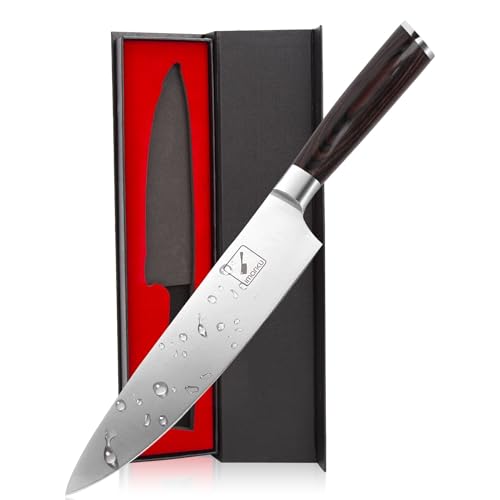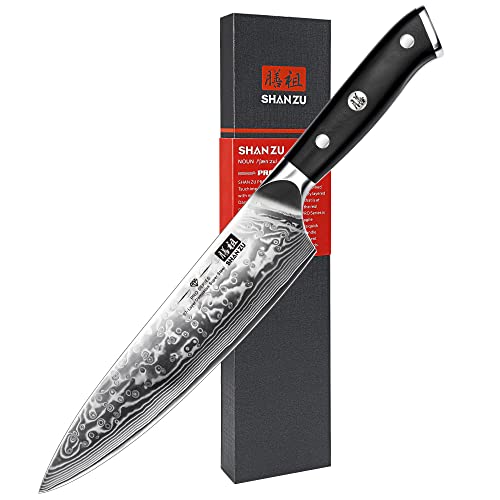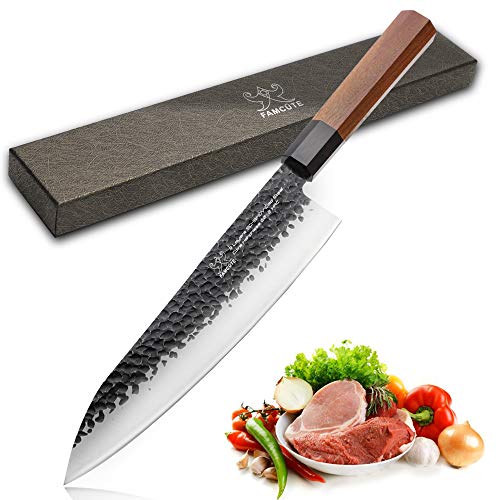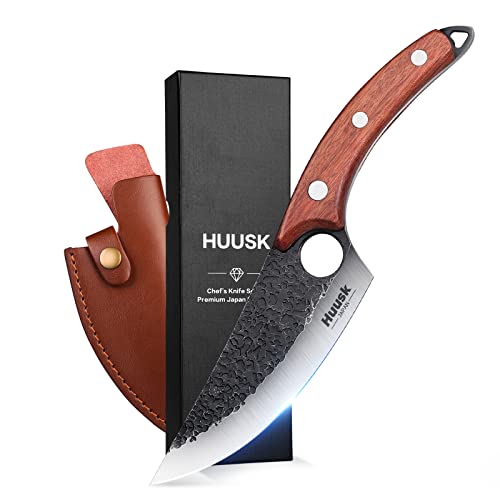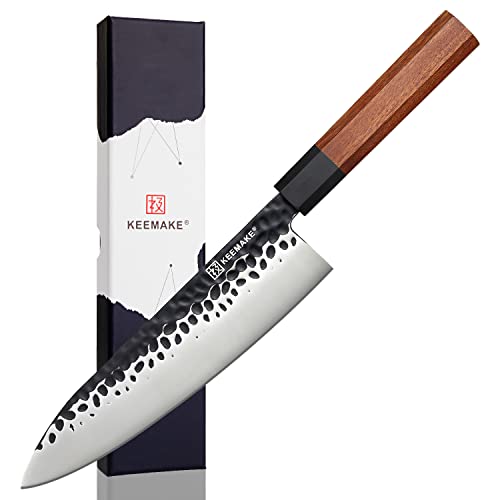- sign in
- Design
- Food
- Pop Culture
- Style
- DIY Classes
The Best Japanese Knives of 2024
E-Commerce WriterPublished on February 12, 2024Last updated on May 25, 2024Japanese knives, where the fusion of beauty, precision, and centuries-old tradition come together to create an exquisite culinary tool. They are more than just kitchenware; they represent the soul of Japan's cultural heritage. They are a testament to the country's meticulous craftsmanship, each blade individually forged and honed to a razor-sharp edge. Known for their unparalleled sharpness, extraordinary edge retention, and beautiful design aesthetics, Japanese knives such as the Imarku Japanese knife, empower chefs to perform at their highest level, enhancing their precision and speed. I'm here to help you explore the diversity of these knives while considering the unique features and the artistry behind their creation.
If you've been hunting for the perfect kitchen blade, look no further than the Imarku Japanese Chef Knife. This 8-inch marvel outperforms its counterparts with its exceptional sharpness. Imagi...
read moreImportant Features- High-carbon stainless steel blade
- Multi-functional gyutou knife design
- Rockwell Hardness Scale of 56-58
- Pakka material handle for stability
- Ultra-sharp edge with Japanese engineering
- Corrosion-resistant blade with 16-18% chrome
If you're passionate about cooking, SHAN ZU's Japanese Chef Knife is a must-have addition to your kitchen. Made with Japanese Steel Damascus, this knife sets a new standard for affordable quality. T...
read moreImportant Features- Made with Damascus Japanese steel AUS-10
- Features 67-layer steel structure
- Frosted glass fiber G10 handle
- Blade length: 8in
- Blade thickness: 2.2mm
- Offers a 12-month warranty
If you want to step up your kitchen game, the FAMCÜTE Japanese Chef Knife is a worthy upgrade from your low-cost knives. This knife boasts an impressively sharp 3-layer Clad Steel blade, whic...
read moreImportant Features- Made with 100% high-quality Japanese steel
- HRC of 60+/-2 for edge longevity
- Clad dimple for easy food release
- Blade length of 21.2cm, handle 15.3cm
- Crafted with African rosewood handle
- Replacement guarantee for quality issues
Seize control of your culinary journey with the Huusk Viking Knives' Hand-Forged Boning Knife, the epitome of Japanese chef knives. With a full tang design, this knife effortlessly blends powe...
read moreImportant Features- Constructed from premium Japanese steel
- Multi-purpose use in kitchen and outdoor activities
- Unique hammered blade texture for corrosion resistance
- Curved wooden handle with large finger hole
- Comes with a protective leather sheath
The KEEMAKE Japanese Chef Knife transcends your everyday kitchen experience with its striking balance of affordability and quality. It is made of Japanese 440C stainless steel and takes center...
read moreImportant Features- Made from Japanese 440C high carbon stainless steel
- Has a hardness rating of 58+ HRC
- Blade features non-stick black coating
- Rust-resistant and easy to clean
- Fitted with a natural rosewood handle
Comparing the Best Japanese Knives of 2024
Best OverallImarku Japanese Chef Knife
If you’ve been hunting for the perfect kitchen blade, look no further than the Imarku Japanese Chef Knife. This 8-inch marvel outperforms its counterparts with its exceptional sharpness. Imagine slicing through the hardest crusts with ease. The Imarku doesn’t just cut; it glides through effortlessly, transforming the tedious task of cutting into a seamless process.
The comfort of this Japanese knife handle is just as impressive as its sharpness. It contours perfectly to your hand, providing a firm yet comfortable grip that optimizes precision and control. This knife not only eases your culinary tasks but also makes them enjoyable, making it our top overall pick.
Pros- Extremely sharp for easy chopping
- Comfortable and sturdy handle
- Efficient at cutting through crusts
Cons- Requires slow initial cutting motion
Best ValueSHAN ZU Japanese Chef Knife
If you’re passionate about cooking, SHAN ZU’s Japanese Chef Knife is a must-have addition to your kitchen. Made with Japanese Steel Damascus, this knife sets a new standard for affordable quality. The robustness and precision of this knife outshine others in its price range. The high-carbon super steel utility knife enhances your culinary experience and is durable for daily kitchen chores.
This Japanese knife shines when it comes to cutting fruits and vegetables. The razor-sharp blade offers a seamless slicing experience, maintaining the freshness and aesthetics of your produce. The superior construction of the knife ensures a comfortable grip, enabling you to make precise cuts effortlessly. This chef’s knife masters the art of marrying functionality with affordability, making it an ideal recommendation for those looking to upgrade their kitchen tools.
Pros- Affordable yet high-quality knife
- Ergonomic design with full tang
- Great edge retention ability
Cons- The knife can chip easily
If you want to step up your kitchen game, the FAMCÜTE Japanese Chef Knife is a worthy upgrade from your low-cost knives. This knife boasts an impressively sharp 3-layer Clad Steel blade, which means it doesn’t merely make cuts; it glides through ingredients, creating precision slices with less effort. Driven by Japanese craftsmanship, this knife delivers not only in performance but also in durability. It has been designed to withstand the test of daily kitchen use, effectively maintaining its sharpness over time.
Adding to its prowess is the Octagon Handle, which contributes to the knife’s aesthetic appeal and enhances grip, providing comfort and control while you work. And for sushi lovers, this Gyuto knife makes the perfect tool for creating restaurant-quality sushi right in your kitchen.
Pros- Very sharp blade
- Comfortable handle
- Excellent value for money
Cons- Dulls quickly compared to others
Best for MeatHuusk Japanese Knives
Seize control of your culinary journey with the Huusk Viking Knives’ Hand-Forged Boning Knife, the epitome of Japanese chef knives. With a full tang design, this knife effortlessly blends power and finesse, making it excellent for cutting meat. The knife’s hand-forged, razor-sharp blade slices through meat like butter, providing precise cuts every time. It’s the perfect tool for efficient and enjoyable cooking, whether preparing a simple home-cooked meal or a grand Thanksgiving or Christmas feast.
This Japanese knife isn’t just about power but also durability and versatility. Its full tang design ensures the utmost stability and longevity. It’s adept at slicing meat and effective for cutting through bone, showcasing its versatility. The knife has a sheath for safe storage and is perfect for indoor and outdoor use, making it a great companion for camping trips.
Pros- Excels in cutting through bones and meat
- Easy to sharpen and maintains sharp edge
- Strong and durable build quality
Cons- High care maintenance required
Best for Everyday UseKEEMAKE Japanese Chef Knife
The KEEMAKE Japanese Chef Knife transcends your everyday kitchen experience with its striking balance of affordability and quality. It is made of Japanese 440C stainless steel and takes center stage for sharpness and durability. The blade maintains its cutting edge even with frequent use, saving the hassle of constant re-sharpening. Its rosewood handle adds an aesthetically pleasing touch and provides a comfortable grip for easy handling.
This Gyuto Knife, with its G10 bolster, doesn’t just cut through meat; it glides, making food preparation effortless. The 8-inch blade is a versatile tool suitable for various culinary tasks in your kitchen. This meat knife brings the precision of professional chefs to your home, transforming even mundane cooking into a gourmet experience.
Pros- Affordable and durable
- Sharp with good edge retention
- Non-stick, easy-clean design
Cons- Lacks balance and feels heavy
Choosing the Perfect Japanese Knife: A Buying Guide
If you’re a culinary enthusiast, you would agree that nothing matches the precision and artistry of Japanese knives. The exquisite craftsmanship, sharpness, and comfortable grip bring a unique finesse to your cooking. But finding the best Japanese knives involves more than just picking the most expensive one on the shelf. It requires a deep understanding of its features, your cooking needs, and, most importantly, the nuances of knife quality. This guide will explore the attributes you should consider when buying Japanese knives.
Steel Quality
Let’s dive into the core of the knife – the steel. Superior steel quality substantially influences the knife’s sharpness, durability, and ease of sharpening. Japanese knives often employ high-carbon steel, renowned for its sharpness and edge-retention. However, it demands regular maintenance to prevent rusting. Alternatively, you could consider stainless steel knives that resist corrosion effectively but may challenge you when sharpening. Therefore, determine your willingness to take knife care before deciding on the steel type.
Blade Type
Different cooking tasks demand different blade types. For instance, a Gyuto (chef’s knife) proves versatile in handling various kitchen tasks, while a Yanagiba (slicing knife) excels in filleting fish. There’s the Santoku, a multipurpose knife, and Usuba, a vegetable knife, among others. Hence, understand your cooking style and frequency to decide on the blade type.
Knife Weight
The weight of a Japanese knife often dictates how it feels in your hand. Some chefs prefer the control and precision that a lightweight knife offers, while others find the heft of a heavier knife satisfying, believing it does more of the work. Your choice should provide a comfortable balance in your hand, ensuring seamless and enjoyable cooking.
Handle Design
Most Japanese knives feature either a traditional Japanese handle or a Western-style handle. Traditional handles are typically cylindrical, light, and made from Ho wood, whereas Western handles are heavier, contoured for a comfortable grip, and often made from synthetic materials. Your choice should rely on the comfort and control the handle offers.
Knife Length
The length of your knife depends on personal preference and the size of your kitchen space. A longer knife could streamline your process if you regularly handle large amounts of produce or cook in large quantities. However, if you’re more comfortable with precision tasks or have limited space, a shorter knife might be your best friend.
Price
Pricing of Japanese knives varies extensively, depending on the craftsmanship, materials used, and brand reputation. While high-end knives can indeed offer superior performance and longevity, not all quality knives need to break the bank. Identify your budget and requirements, then scout for a knife that delivers maximum value for your investment.
Japanese Knife FAQs
Q: What is special about Japanese knives?A: Japanese knives are renowned for their exceptional craftsmanship, sharpness, and durability. They are often handcrafted and have specific purposes in cooking, such as filleting fish or slicing vegetables.'
Q: How should I clean a Japanese knife?A: You should clean your Japanese knife immediately after using it. Use warm water and a mild detergent, then dry it immediately to avoid rusting. Avoid using dishwashers as it can damage the blade and handle.'
Q: What is the best way to store Japanese knives?A: Japanese knives should be stored in a knife block, magnetic knife strip, or a special knife case. It's important to keep them in a dry place to prevent rusting and keep the blades sharp.'
Q: How do I maintain the sharpness of my Japanese knife?A: You should use a whetstone to sharpen your Japanese knife. It's also advisable not to use the knife on hard surfaces like bones or frozen foods to maintain its sharpness.'
Q: Why is my Japanese knife rusting?A: Japanese knives can rust if they are not dried immediately after washing. Also, high carbon steel, which is commonly used in Japanese knives, is more prone to rusting. You can remove rust using a soft cloth and a knife rust remover.'
Q: Why is my Japanese knife chipping?A: Chipping can occur if the knife is used on hard surfaces or if it's not handled correctly. To avoid this, make sure to use a proper cutting surface and don't exert too much force when using the knife.'
Q: Can I use a Japanese knife for any type of food?A: While Japanese knives can be used for a variety of foods, each knife type has a specific purpose. For example, a Deba knife is used for filleting fish while a Nakiri knife is ideal for chopping vegetables.'
Q: What is the difference between a Japanese knife and a western knife?A: The primary difference is in the design. Japanese knives are usually lighter and sharper, with a singular edge. Western knives, on the other hand, are typically heavier and have a double-edged blade.'
We may earn a commission if you make a purchase through one of our links. The newsroom or editorial staff was not involved in the creation of this content.Natalie is a graduate from the Ohio State University where she studied English. She edits content about lifestyle and education. In her free time, she enjoys trying new recipes, reading in the park, and exploring her city of Columbus, Ohio.

